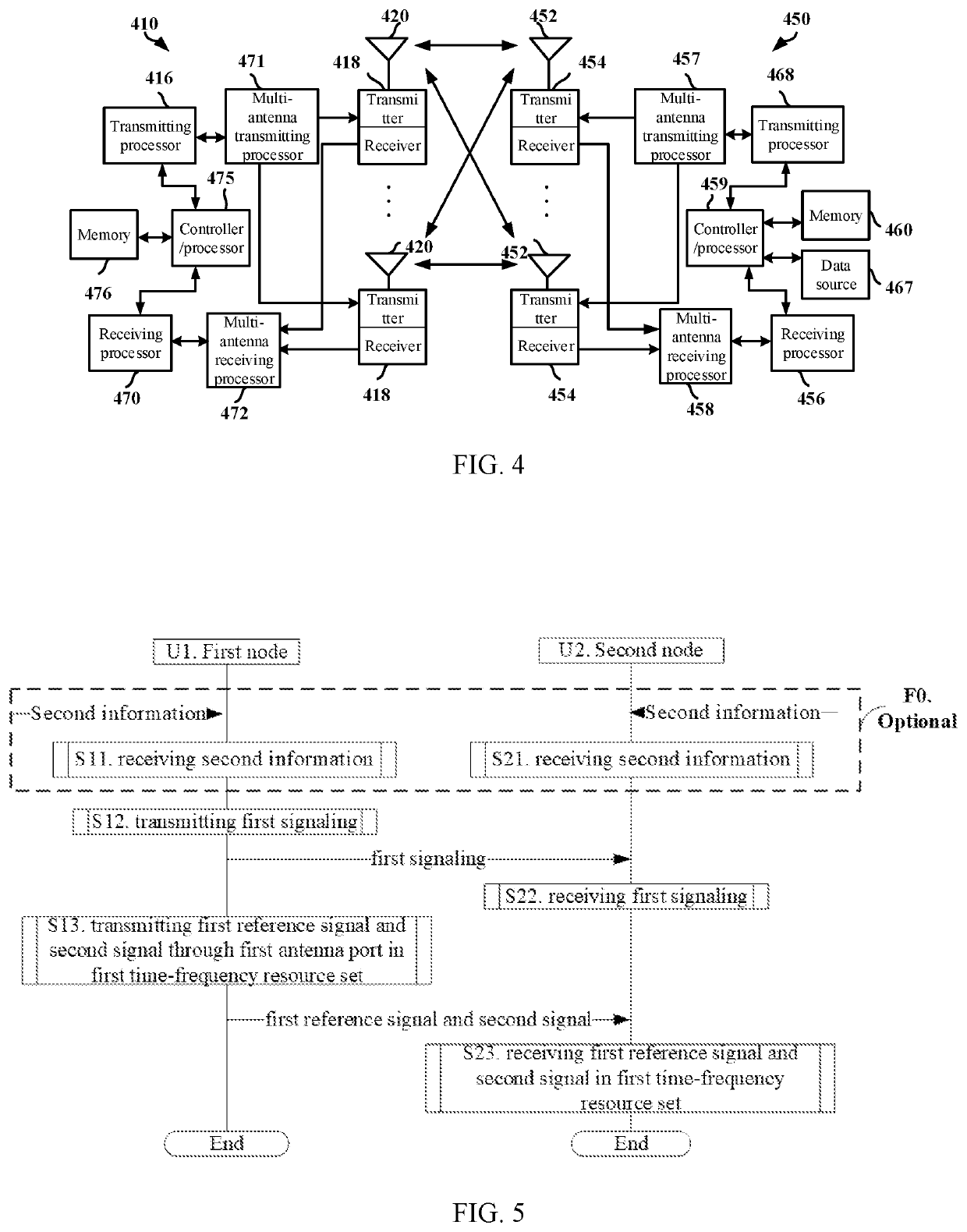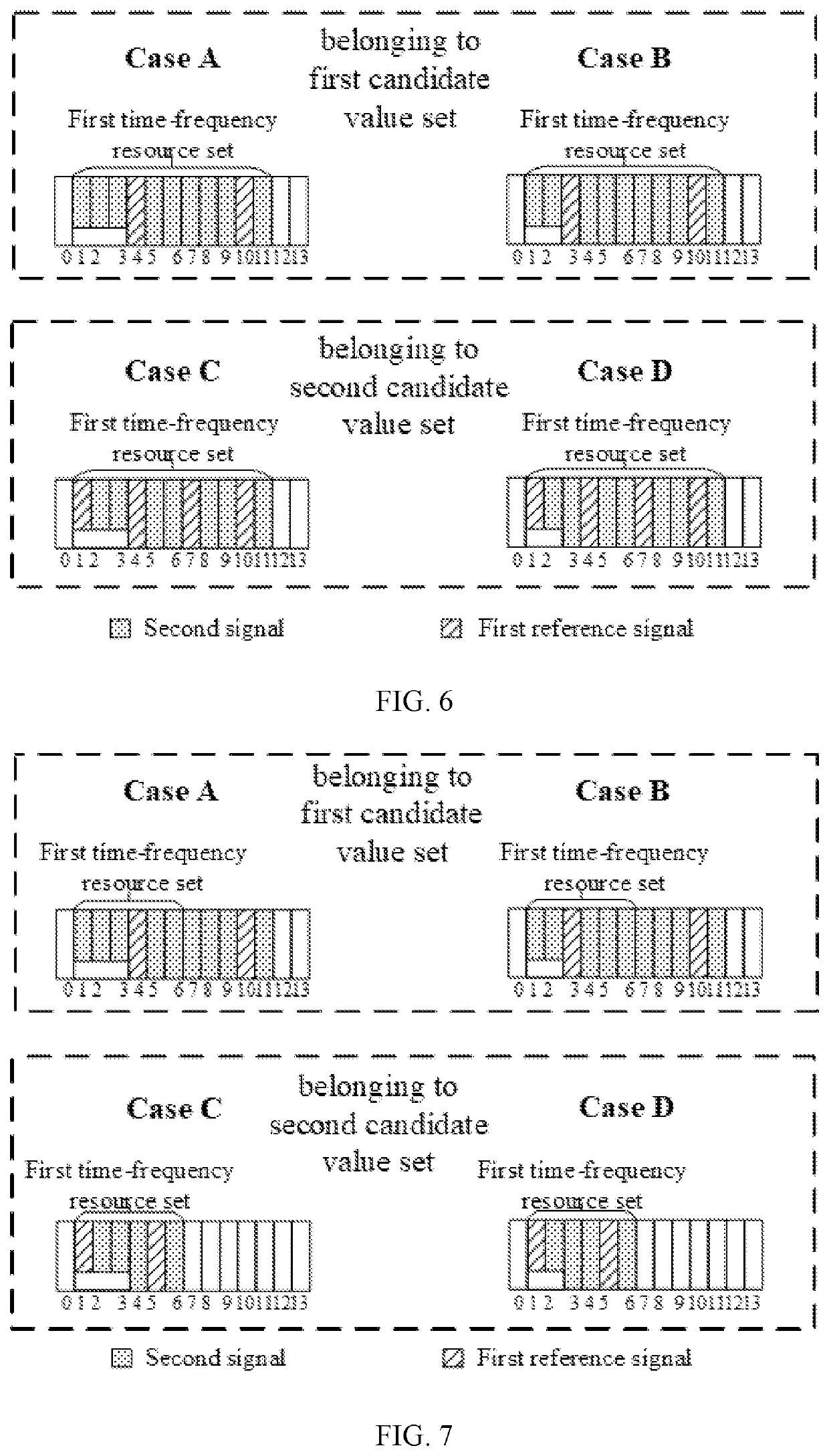Method and device in nodes used for wireless communication
a wireless communication and node technology, applied in wireless communication, transmission path sub-channel allocation, transportation and packaging, etc., can solve the problems of flexible and the signaling overhead of tci state indication
- Summary
- Abstract
- Description
- Claims
- Application Information
AI Technical Summary
Benefits of technology
Problems solved by technology
Method used
Image
Examples
embodiment 1
[0078]Embodiment 1 illustrates a flowchart of the processing of a first node according to one embodiment of the present application, as shown in FIG. 1. In FIG. 1, each block represents a step. In embodiment 1, a first node in the present application first transmits a first signaling in step 101; then transmits a first reference signal and a second signal through a first antenna port in a first time-frequency resource set in step 102; the first signaling is used to indicate the first time-frequency resource set, and the first signaling is used to indicate a number of time-frequency resource(s) used for the first reference signal in the first time-frequency resource set; the first reference signal is used to demodulate the second signal; the first antenna port conforms to a first QCL relationship, and the first QCL relationship is one of Q candidate QCL relationships; any of the Q candidate QCL relationships comprises at least one of a candidate reference signal or a QCL type; the nu...
embodiment 2
[0314]Embodiment 2 illustrates a schematic diagram of a network architecture according to the present application, as shown in FIG. 2.
[0315]FIG. 2 illustrates a network architecture 200 of 5G NR, Long-Term Evolution (LTE) and Long-Term Evolution Advanced (LTE-A) systems. The 5G NR or LTE network architecture 200 may be called a 5G System (5GS) / Evolved Packet System (EPS) 200 or other appropriate terms. The 5GS / EPS 200 may comprise one or more UEs 201, an NG-RAN 202, a 5G Core Network / Evolved Packet Core (5GC / EPC) 210, a Home Subscriber Server (HSS) / Unified Data Management (UDM) 220 and an Internet Service 230. The 5GS / EPS 200 may be interconnected with other access networks. For simple description, the entities / interfaces are not shown. As shown in FIG. 2, the 5GS / EPS 200 provides packet switching services. Those skilled in the art will readily understand that various concepts presented throughout the present application can be extended to networks providing circuit switching servic...
embodiment 3
[0330]Embodiment 3 illustrates a schematic diagram of an example of a radio protocol architecture of a user plane and a control plane according to one embodiment of the present application, as shown in FIG. 3. FIG. 3 is a schematic diagram illustrating an embodiment of a radio protocol architecture of a user plane 350 and a control plane 300. In FIG. 3, the radio protocol architecture for a first communication node (UE, gNB or an RSU in V2X) and a second communication node (gNB, UE or an RSU in V2X), or between two UEs is represented by three layers, which are a layer 1, a layer 2 and a layer 3, respectively. The layer 1 (L1) is the lowest layer and performs signal processing functions of various PHY layers. The L1 is called PHY 301 in the present application. The layer 2 (L2) 305 is above the PHY 301, and is in charge of a link between a first communication node and a second communication node, as well as two UEs via the PHY 301. L2 305 comprises a Medium Access Control (MAC) subla...
PUM
 Login to View More
Login to View More Abstract
Description
Claims
Application Information
 Login to View More
Login to View More - R&D
- Intellectual Property
- Life Sciences
- Materials
- Tech Scout
- Unparalleled Data Quality
- Higher Quality Content
- 60% Fewer Hallucinations
Browse by: Latest US Patents, China's latest patents, Technical Efficacy Thesaurus, Application Domain, Technology Topic, Popular Technical Reports.
© 2025 PatSnap. All rights reserved.Legal|Privacy policy|Modern Slavery Act Transparency Statement|Sitemap|About US| Contact US: help@patsnap.com



